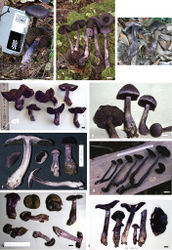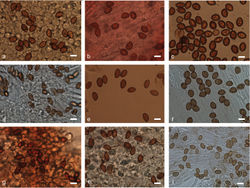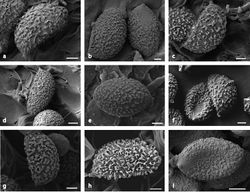Cortinarius kioloensis
| Notice: | This page is derived from the original publication listed below, whose author(s) should always be credited. Further contributors may edit and improve the content of this page and, consequently, need to be credited as well (see page history). Any assessment of factual correctness requires a careful review of the original article as well as of subsequent contributions.
If you are uncertain whether your planned contribution is correct or not, we suggest that you use the associated discussion page instead of editing the page directly. This page should be cited as follows (rationale):
Citation formats to copy and paste
BibTeX: @article{Harrower2015MycoKeys, RIS/ Endnote: TY - JOUR Wikipedia/ Citizendium: <ref name="Harrower2015MycoKeys">{{Citation See also the citation download page at the journal. |
Ordo: Agaricales
Familia: Cortinariaceae
Genus: Cortinarius
Name
Cortinarius kioloensis Wood, 2009 – Wikispecies link – Pensoft Profile
Type
AUSTRALIA. New South Wales: Batemans Bay, Kioloa State Forest, Eucalypt woodland, 22 Jun. 1980, S. Lowry (holotype: UNSW 83/781).
Description
Pileus 45–120 mm wide, convex to plano-convex with a low, broad umbo with age, surface dry, tomentulose-squamulose, dark violet (17F8), lighter concolorous (17E3) near margin, red in KOH; margin entire, split and broadly undulating with age. Lamellae close, sinuate, thick, broad to ventricose, deep blue (19D–E8). Stipe 105–165 mm long, 7–28 mm thick at apex, 9–31 mm thick at base, bulbous, light violet (18A3–5) turning deep blue (18F8) upon touch because of the copious universal veil. Universal veil pale violet (17A3). Basal mycelium pale violet (17A3). Context at apex dark violet to black (18F8).
Basidiospores 10.5–14 µm × 6.5–9 µm, means = 11.5–12.5 µm × 7.5–8 µm, Q = 1.41–1.63, Q means = 1.45–1.60 (125 spores, 5 specimens), ellipsoid to amygdaloid, strongly verrucose, plage present under SEM. Basidia 4-spored, clavate, (27) 35–49 µm × 8–12 µm. Cheilocystidia ventricose to lageniform, sometimes strangulated, brown in KOH, (50–) 60–100 (–127) µm × (10–) 15–30 (–35) µm. Pleurocystidia narrowly conical to lageniform, sometimes strangulated, brown or grey in KOH, (50–) 60–90 (–105) µm × (15–) 20–25 (–30) µm. Caulocystidia absent but brown vacuolar pigment in some hyphae of the caulopellis. Pileipellis a trichoderm composed of fasicles of multiseptate hyphae, 8–20 µm wide, smooth, terminal cells clavate to lanceolate, with brown contents in KOH. Clamp connections present.
Ecology and distribution
With Eucalyptus and/or Allocasuarina in southeast Australia. With Leptospermum in New Zealand. Fruiting April to July.
Other specimens examined
Australia. Tasmania: Florentine River Valley, Pagoda Hut, on soil under Eucalyptus and Allocasuarina, 23 Apr. 2003, D.A. Ratkowsky (MEL 2351101). New South Wales: Swans Crossing State Forest (Eucalyptus), 21 May 2003, I. Dodd 70845 (TENN 069666). New Zealand. Auckland: Waitakere Ranges, Little Huia, Donald Mclean Track, 10 July 2010, C. Shirley AK375 (PDD 99307). Auckland: Waitakere, Piha Rd, Upper Nihotupu Dam track, (Leptospermum), 24 July 2010, C. Shirley AK373 (PDD 99309). Auckland: Waitakere, Mountain Rd, Opanuku Pipeline Track, (Leptospermum), 17 July 2010, C. Shirley AK370 (PDD 99308).
Discussion
The collections examined here match the protologue of Cortinarius kioloensis Wood in all particulars. One collection (TENN 069666) was seen to have dark purple, nearly black flesh at the apex. Flesh color at the base was not observed. We have not studied the type of this species (the collection was not readily available at UNSW) but are confident for now applying the name Cortinarius kioloensis to our material. As such, the species range has been extended from N. S. W. into Tasmania and New Zealand and a new host association with Leptospermum has been revealed. Cortinarius atroviolaceus and Cortinarius kioloensis cannot be distinguished morphologically, but the two are geographically separated and likely ecologically differentiated. Cortinarius atroviolaceus is found at 1700 m on Mt. Kinabalu, Malaysia where Leptospermum (Myrtaceae), Trigonobalanus (Fagales), Quercus (Fagales), Lithocarpus (Fagales), and Castanopsis (Fagales) may occur (Beaman et al. 2000[1]; Beaman and Anderson 2004[2]). Cortinarius kioloensis is found with Eucalyptus (Myrtaceae) and/or Allocasuarina (Casuarinaceae) in southeastern Australia and with Leptospermum (Myrtaceae) in New Zealand. Herbarium collections of Cortinarius kioloensis from New Zealand have been misidentified as Cortinarius subcalyptrosporus. Cortinarius kioloensis differs from Cortinarius subcalyptrosporus by the non-calyptrate basidiospores. It differs from Cortinarius atrolazulinus by association with Myrtaceae, not Nothofagaceae. Cortinarius kioloensis is also similar to Cortinarius carneipallidus, a Nothofagus association, but differs from this latter species by association with Myrtaceae. Phylogenetic results (Fig. 1) also support these separations. Unique molecular synapomorphies are present at pos. 11, 35, 203 (ITS1), 475, 554, 577, 578, 623 (ITS2) of our alignment. Cortinarius kioloensis was treated as “Cortinarius sp. AU1” in Harrower et al. (2015)[3].
Taxon Treatment
- Harrower, E; Bougher, N; Winterbottom, C; Henkel, T; Horak, E; Matheny, P; 2015: New species in Cortinarius section Cortinarius (Agaricales) from the Americas and Australasia MycoKeys, (11): 1-21. doi
Images
|
Other References
- ↑ Beaman J, Anderson C, Beaman R (2000) The Plants of Mount Kinabalu: 4. Dicotyledon families Acanthaceae to Lythraceae. Natural History Publications, Borneo, 1–588.
- ↑ Beaman J, Anderson C (2004) The Plants of Mt. Kinabalu: 5. Dicotyledon families: Magnoliaceae to Winteraceae. Natural History Publications, Borneo, 1–609.
- ↑ Harrower E, Bougher N, Henkel T, Horak E, Matheny P (2015) Long-distance dispersal and speciation of Australasian and American species of Cortinarius sect. Cortinarius. Mycologia 107(4): 697–709.



